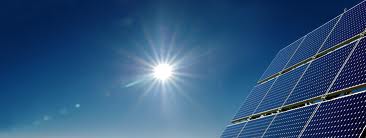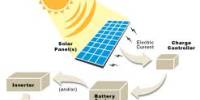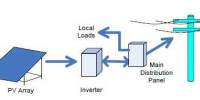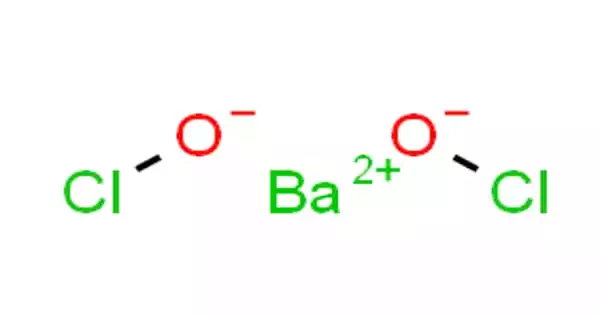Introduction
The interest in renewable energy has been revived over last few year, especially after global awareness regarding the ill effects of fossil fuel burning. Energy is the source of growth and the mover for economic and social development of a nation and its people. No matter how we cry about development or poverty alleviation it is not going to come until lights are provided to our people for seeing, reading and working.
Natural resources or energy sources such as; fossil fuels, oil natural gas, etc. are completely used or economically depleted. Because we are rapidly exhausting, our non-renewable resources, degrading the potentially renewable resources and even threatening the perpetual resources. It demands immediate attention especially in the third world countries, where only scarce resources are available for an enormous size of population. The civilization is dependent on electric power. There is a relationship between GDP growth rate and electricity growth rate in a country.
Clearly, the present gas production capacity in Bangladesh can’t support both domestic gas needs, as well as wider electricity generation for the country . On September 15th 2009, the Power Division of the Ministry of Power, Energy and Mineral Resources of Bangladesh pushed for urgent action to be taken to improve the country’s energy outlook. The Power Division made recommendation such as ceasing gas supply to gas-fired power plants after 2012 to conserve gas reserves for domestic use.
The Government of Bangladesh is actively engaged in energy crisis management. The National Energy Policy has the explicit goal of supplying the whole country with electricity by 2020. Since 1996, the government has allowed private, independent power producer to enter the Bangladeshi market. It is already importing 100 Megawatts of power from India and has negotiated with private companies renting plants to buy power at higher rates.
It is impossible to conceive development of civilization without “Energy”.Densely populated country like Bangladesh can only sustain and progress if only latest energy technologies can be used efficiently. Government of Bangladesh is working towards achieving “Power i.e. Electricity for All” by the year 2020.Bangladesh is one of the most severely affected counties of the World due to climate change and global warming effects.
What Is Solar Energy?
Solar energy is energy that comes from the sun. Every day the sun radiates, or sends out, an enormous amount of energy. The sun radiates more energy in one second than people have used since the beginning of time!
Where does all this energy come from? It comes from within the sun itself. Like other stars, the sun is a big gas ball made up mostly of hydrogen and helium. The sun generates energy in its core in a process called nuclear fusion. During nuclear fusion, the sun’s extremely high pressure and hot temperature cause hydrogen atoms to come apart and their nuclei (the central cores of the atoms) to fuse or combine. Four hydrogen nuclei fuse to become one helium atom. But the helium atom weighs less than the four nuclei that combined to form it. Some matter is lost during nuclear fusion. The lost matter is emitted into space as radiant energy.
It takes millions of years for the energy in the sun’s core to make its way to the solar surface, and then just a little over eight minutes to travel the 93 million miles to earth. The solar energy travels to the earth at a speed of 186,000 miles per second, the speed of light. Only a small portion of the energy radiated by the sun into space strikes the earth, one part in two billion. Yet this amount of energy is enormous. Every day enough energy strikes the United States to supply the nation’s energy needs for one and a half years!
Where does all this energy go? About 15 percent of the sun’s energy that hits the earth is reflected back into space. Another 30 percent is used to evaporate water, which, lifted into the atmosphere, produce’s rain-fall. Solar energy also is absorbed by plants, the land, and the oceans. The rest could be used to supply our energy needs.
History of Solar Energy
People have harnessed solar energy for centuries. As early as the 7th century B.C., people used simple magnifying glasses to concentrate the light of the sun into beams so hot they would cause wood to catch fire. Over 100 years ago in France, a scientist used heat from a solar collector to make steam to drive a steam engine.
In the beginning of this century, scientists and engineers began researching ways to use solar energy in earnest. One important development was a remarkably efficient solar boiler invented by Charles Greeley Abbott, an American astrophysicist, in 1936.
The solar water heater gained popularity at this time in Florida, California, and the Southwest. The industry started in the early 1920s and was in full swing just before World War 11. This growth lasted until the mid- 1950s when low-cost natural gas became the primary fuel for heating American homes. The public and world governments remained largely indifferent to the possibilities of solar energy until the oil shortages of the 1970s. Today people use solar energy to heat buildings and water and to generate electricity.
Utilization of solar Energy
Solar energy, radiant light and heat from the sun, has been harnessed by humans since ancient times using a range of ever-evolving technologies. Solar radiation, along with secondary solar-powered resources such as wind and wave power, hydroelectricity and biomass, account for most of the available renewable energy on earth. Only a minuscule fraction of the available solar energy is used.
Solar powered electrical generation relies on heat engines and photovoltaic. Solar energy’s uses are limited only by human ingenuity. A partial list of solar applications includes space heating and cooling through solar architecture, potable water via distillation and disinfection, day lighting, solar hot water, solar cooking, and high temperature process heat for industrial purposes. To harvest the solar energy, the most common way is to use solar panels.
Solar technologies are broadly characterized as either passive solar or active solar depending on the way they capture, convert and distribute solar energy. Active solar techniques include the use of photovoltaic panels and solar thermal collectors to harness the energy. Passive solar techniques include orienting a building to the Sun, selecting materials with favorable thermal mass or light dispersing properties, and designing spaces that naturally circulate air.
There are main two ways we can produce electricity from the sun:
Photovoltaic Electricity – This method uses photovoltaic cells that absorb the direct sunlight just like the solar cells you see on some calculators.
Solar Thermal Electricity – This also uses a solar collector: it has a mirrored surface that reflects the sunlight onto a receiver that heats up a liquid. This heated liquid is used to make steam that produces electricity.
Solar System Descriptions
In today’s climate of growing energy needs and increasing environmental concern, alternatives to the use of non-renewable and polluting fossil fuels have to be investigated. One such alternative is solar energy.
Solar energy is quite simply the energy produced directly by the sun and collected elsewhere, normally the Earth. The sun creates its energy through a thermonuclear process that converts about 650,000,0001 tons of hydrogen to helium every second. The process creates heat and electromagnetic radiation. The heat remains in the sun and is instrumental in maintaining the thermonuclear reaction. The electromagnetic radiation (including visible light, infra-red light, and ultra-violet radiation) streams out into space in all directions.
Only a very small fraction of the total radiation produced reaches the Earth. The radiation that does reach the Earth is the indirect source of nearly every type of energy used today. The exceptions are geothermal energy, and nuclear fission and fusion. Even fossil fuels owe their origins to the sun; they were once living plants and animals whose life was dependent upon the sun.
Much of the world’s required energy can be supplied directly by solar power. More still can be provided indirectly. The practicality of doing so will be examined, as well as the benefits and drawbacks. In addition, the uses solar energy is currently applied to will be noted.
Due to the nature of solar energy, two components are required to have a functional solar energy generator. These two components are a collector and a storage unit. The collector simply collects the radiation that falls on it and converts a fraction of it to other forms of energy (either electricity and heat or heat alone). The storage unit is required because of the non-constant nature of solar energy; at certain times only a very small amount of radiation will be received. At night or during heavy cloud cover, for example, the amount of energy produced by the collector will be quite small. The storage unit can hold the excess energy produced during the periods of maximum productivity, and release it when the productivity drops. In practice, a backup power supply is usually added, too, for the situations when the amount of energy required is greater than both what is being produced and what is stored in the container.
Methods of collecting and storing solar energy vary depending on the uses planned for the solar generator. In general, there are three types of collectors and many forms of storage units.
The three types of collectors are flat-plate collectors, focusing collectors, and passive collectors.
Flat-plate collectors are the more commonly used type of collector today. They are arrays of solar panels arranged in a simple plane. They can be of nearly any size, and have an output that is directly related to a few variables including size, facing, and cleanliness. These variables all affect the amount of radiation that falls on the collector. Often these collector panels have automated machinery that keeps them facing the sun. The additional energy they take in due to the correction of facing more than compensates for the energy needed to drive the extra machinery.
Focusing collectors are essentially flat-plane collectors with optical devices arranged to maximize the radiation falling on the focus of the collector. These are currently used only in a few scattered areas. Solar furnaces are examples of this type of collector. Although they can produce far greater amounts of energy at a single point than the flat-plane collectors can, they lose some of the radiation that the flat-plane panels do not. Radiation reflected off the ground will be used by flat-plane panels but usually will be ignored by focusing collectors (in snow covered regions, this reflected radiation can be significant). One other problem with focusing collectors in general is due to temperature. The fragile silicon components that absorb the incoming radiation lose efficiency at high temperatures, and if they get too hot they can even be permanently damaged. The focusing collectors by their very nature can create much higher temperatures and need more safeguards to protect their silicon components.
Passive collectors are completely different from the other two types of collectors. The passive collectors absorb radiation and convert it to heat naturally, without being designed and built to do so. All objects have this property to some extent, but only some objects (like walls) will be able to produce enough heat to make it worthwhile. Often their natural ability to convert radiation to heat is enhanced in some way or another (by being painted black, for example) and a system for transferring the heat to a different location is generally added.
People use energy for many things, but a few general tasks consume most of the energy. These tasks include transportation, heating, cooling, and the generation of electricity. Solar energy can be applied to all four of these tasks with different levels of success.
Heating is the business for which solar energy is best suited. Solar heating requires almost no energy transformation, so it has a very high efficiency. Heat energy can be stored in a liquid, such as water, or in a packed bed. A packed bed is a container filled with small objects that can hold heat (such as stones) with air space between them. Heat energy is also often stored in phase-change or heat-of-fusion units. These devices will utilize a chemical that changes phase from solid to liquid at a temperature that can be produced by the solar collector. The energy of the collector is used to change the chemical to its liquid phase, and is as a result stored in the chemical itself. It can be tapped later by allowing the chemical to revert to its solid form. Solar energy is frequently used in residential homes to heat water. This is an easy application, as the desired end result (hot water) is the storage facility. A hot water tank is filled with hot water during the day, and drained as needed. This application is a very simple adjustment from the normal fossil fuel water heaters.
Swimming pools are often heated by solar power. Sometimes the pool itself functions as the storage unit, and sometimes a packed bed is added to store the heat. Whether or not a packed bed is used, some method of keeping the pool’s heat for longer than normal periods (like a cover) is generally employed to help keep the water at a warm temperature when it is not in use.
Solar energy is often used to directly heat a house or building. Heating a building requires much more energy than heating a building’s water, so much larger panels are necessary. Generally a building that is heated by solar power will have its water heated by solar power as well. The type of storage facility most often used for such large solar heaters is the heat-of-fusion storage unit, but other kinds (such as the packed bed or hot water tank) can be used as well. This application of solar power is less common than the two mentioned above, because of the cost of the large panels and storage system required to make it work. Often if an entire building is heated by solar power, passive collectors are used in addition to one of the other two types. Passive collectors will generally be an integral part of the building itself, so buildings taking advantage of passive collectors must be created with solar heating in mind.
These passive collectors can take a few different forms. The most basic type is the incidental heat trap. The idea behind the heat trap is fairly simple. Allow the maximum amount of light possible inside through a window (The window should be facing towards the equator for this to be achieved) and allow it to fall on a floor made of stone or another heat holding material. During the day, the area will stay cool as the floor absorbs most of the heat, and at night, the area will stay warm as the stone re-emits the heat it absorbed during the day. Another major form of passive collector is thermos phonin walls and/or roof. With this passive collector, the heat normally absorbed and wasted in the walls and roof is re-routed into the area that needs to be heated.
The last major form of passive collector is the solar pond. This is very similar to the solar heated pool described above, but the emphasis is different. With swimming pools, the desired result is a warm pool. With the solar pond, the whole purpose of the pond is to serve as an energy regulator for a building. The pond is placed either adjacent to or on the building, and it will absorb solar energy and convert it to heat during the day. This heat can be taken into the building, or if the building has more than enough heat already, heat can be dumped from the building into the pond.
Solar energy can be used for other things besides heating. It may seem strange, but one of the most common uses of solar energy today is cooling. Solar cooling is far more expensive than solar heating, so it is almost never seen in private homes. Solar energy is used to cool things by phase changing a liquid to gas through heat, and then forcing the gas into a lower pressure chamber. The temperature of a gas is related to the pressure containing it, and all other things being held equal, the same gas under a lower pressure will have a lower temperature. This cool gas will be used to absorb heat from the area of interest and then be forced into a region of higher pressure where the excess heat will be lost to the outside world. The net effect is that of a pump moving heat from one area into another, and the first is accordingly cooled.
Besides being used for heating and cooling, solar energy can be directly converted to electricity. Most of our tools are designed to be driven by electricity, so if you can create electricity through solar power, you can run almost anything with solar power. The solar collectors that convert radiation into electricity can be either flat-plane collectors or focusing collectors, and the silicon components of these collectors are photovoltaic cells.
Photovoltaic cells, by their very nature, convert radiation to electricity. This phenomenon has been known for well over half a century, but until recently the amounts of electricity generated were good for little more than measuring radiation intensity. Most of the photovoltaic cells on the market today operate at an efficiency of less than 15%; that is, of all the radiation that falls upon them, less than 15% of it is converted to electricity. The maximum theoretical efficiency for a photovoltaic cell is only 32.3%, but at this efficiency, solar electricity is very economical. Most of our other forms of electricity generation are at a lower efficiency than this.
Unfortunately, reality still lags behind theory and a 15% efficiency is not usually considered economical by most power companies, even if it is fine for toys and pocket calculators. Hope for bulk solar electricity should not be abandoned, however, for recent scientific advances have created a solar cell with an efficiency of 28.2% efficiency in the laboratory. This type of cell has yet to be field-tested. If it maintains its efficiency in the uncontrolled environment of the outside world, and if it does not have a tendency to break down, it will be economical for power companies to build solar power facilities after all.
Of the main types of energy usage, the least suited to solar power is transportation. While large, relatively slow vehicles like ships could power themselves with large onboard solar panels, small constantly turning vehicles like cars could not. The only possible way a car could be completely solar powered would be through the use of battery that was charged by solar power at some stationary point and then later loaded into the car. Electric cars that are partially powered by solar energy are available now, but it is unlikely that solar power will provide the world’s transportation costs in the near future.
Solar power has two big advantages over fossil fuels. The first is in the fact that it is renewable; it is never going to run out. The second is its effect on the environment.
While the burning of fossil fuels introduces many harmful pollutants into the atmosphere and contributes to environmental problems like global warming and acid rain, solar energy is completely non-polluting. While many acres of land must be destroyed to feed a fossil fuel energy plant its required fuel, the only land that must be destroyed for a solar energy plant is the land that it stands on. Indeed, if a solar energy systems were incorporated into every business and dwelling, no land would have to be destroyed in the name of energy. This ability to decentralize solar energy is something that fossil fuel burning cannot match.
As the primary element of construction of solar panels, silicon, is the second most common element on the planet, there is very little environmental disturbance caused by the creation of solar panels. In fact, solar energy only causes environmental disruption if it is centralized and produced on a gigantic scale. Solar power certainly can be produced on a gigantic scale, too. Among the renewable resources, only in solar power do we find the potential for an energy source capable of supplying more energy than is used.
Suppose that of the 4.5×1017 kWh per annum that is used by the earth to evaporate water from the oceans we were to acquire just 0.1% or 4.5×1014 kWh per annum. Dividing by the hours in the year gives a continuous yield of 2.90×1010 kW. This would supply 2.4 kW to 12.1 billion people.
This translates to roughly the amount of energy used today by the average American available to over twelve billion people. Since this is greater than the estimated carrying capacity of the Earth, this would be enough energy to supply the entire planet regardless of the population.
Unfortunately, at this scale, the production of solar energy would have some unpredictable negative environmental effects. If all the solar collectors were placed in one or just a few areas, they would probably have large effects on the local environment, and possibly have large effects on the world environment. Everything from changes in local rain conditions to another Ice Age has been predicted as a result of producing solar energy on this scale. The problem lies in the change of temperature and humidity near a solar panel; if the energy producing panels are kept non-centralized, they should not create the same local, mass temperature change that could have such bad effects on the environment.
Of all the energy sources available, solar has perhaps the most promise. Numerically, it is capable of producing the raw power required to satisfy the entire planet’s energy needs. Environmentally, it is one of the least destructive of all the sources of energy. Practically, it can be adjusted to power nearly everything except transportation with very little adjustment, and even transportation with some modest modifications to the current general system of travel. Clearly, solar energy is a resource of the future.
Advantage of Solar Energy:
- Technology is easy
- Affordable cost
- Within the ability of poor’s
- Basically no maintenance cost
- Only source of energy is sunshine
- Energy source is cost free
- Environmental Pollution is less
- No emission
- Very few materials are required

















